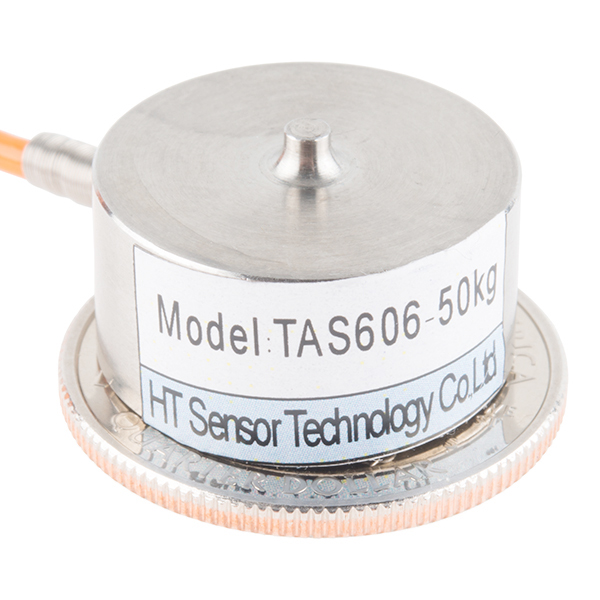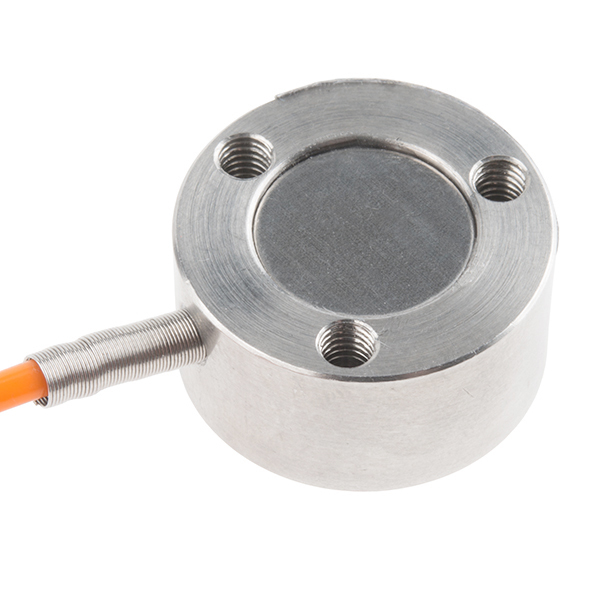This single disc load cell (sometimes called a strain gauge) can translate up to 50kg of pressure (force) into an electrical signal. Each load cell is able to measure the electrical resistance that changes in response to, and proportional of, the strain (e.g. pressure or force) applied to the disc. With this gauge you will be able to tell just how heavy an object is, if an object's weight changes over time, or if you simply need to sense the presence of an object by measuring strain or load applied to a surface.
Disc load cells are a bit easier to mount than bar-style load cells, making them more straightforward to implement into a design.
Each load cell is made from an steel-alloy and is capable of reading a capacity of 50kg. These load cells have four strain gauges that are hooked up in a wheatstone bridge formation. The color code on the wiring is as follows: red = E+, green = O+, black = E-, and white = O-. Additionally, these load cells offer an IP66 protection rating.
- 20mm x 11mm, 2000mm Wire
Load Cell - 50kg, Disc (TAS606) Product Help and Resources
OpenScale Applications and Hookup Guide
July 22, 2016
OpenScale allows you to have a permanent scale for industrial and biological applications. Learn how to use the OpenScale board to read and configure load cells.
Getting Started with Load Cells
June 11, 2015
A tutorial defining what a load cell is and how to use one.
Load Cell Amplifier HX711 Breakout Hookup Guide
July 22, 2016
A hookup guide for the HX711 load cell amplifier breakout board
Qwiic Scale Hookup Guide
April 11, 2019
Create your own digital scale quickly and easily using the Qwiic Scale!
Core Skill: Soldering
This skill defines how difficult the soldering is on a particular product. It might be a couple simple solder joints, or require special reflow tools.
Skill Level: Noob - Some basic soldering is required, but it is limited to a just a few pins, basic through-hole soldering, and couple (if any) polarized components. A basic soldering iron is all you should need.
See all skill levels
Core Skill: Electrical Prototyping
If it requires power, you need to know how much, what all the pins do, and how to hook it up. You may need to reference datasheets, schematics, and know the ins and outs of electronics.
Skill Level: Rookie - You may be required to know a bit more about the component, such as orientation, or how to hook it up, in addition to power requirements. You will need to understand polarized components.
See all skill levels
Comments
Looking for answers to technical questions?
We welcome your comments and suggestions below. However, if you are looking for solutions to technical questions please see our Technical Assistance page.
Customer Reviews
3 out of 5
Based on 2 ratings:
1 of 4 found this helpful:
useless
There is no way to mount anything to the top of this load cell. An entire support structure for whatever you are measuring needs to be built around this load cell for it to be of any use.
It is literally still sitting on my table, never used and probably never will be. Total waste of $60.
I'm afraid you misunderstand how these work, you mount them to a stable surface by attaching them from below and then you apply force to the little nub on the top of the load cell. The load cell then measures force by how much the force on the nub deforms the top of the load cell.
If you have any further questions, please see our technical assistance page and that will get you to someone that can answer your questions.
Great Price, Very Useful in Certain Applications
Industrial and research grade load cells with this small, cylindrical shape cost a lot of money. This one does not. So the primary advantage of this load cell is that you can afford to put a small, compressive load cell in your project in applications where the cost might otherwise be prohibitive. When you use this load cell with the SparkFun Qwiic Scale - NAU7802, and the downloadable freeware that SparkFun makes available, there is going to be a lot of noise in your data. To remove that jitter you will need to average the data to get repeatable results. In your time averaged data you should be able to see 1 kilogram reliably. That is a 2% resolution. Depending on the set up you may be able to see half of that, or around 1 pound, If this is sufficient for you then this is a very economical way to include compressive load measurement in your test fixture, or whatever it is that you are building. The key to using this, or any load sensor, for a measurement is calibration. The closer you calibrate the system to the working weight that you need to measure, the more accurate the result. If you are measuring load around 25 kg,, for instance, you want to calibrate around 25 kg. To do this you will need to use a set of scale weights, or heavy metal parts whose weight you have determined on a scale with known calibration.




I have a small bar load cell, it clearly has mounting screw holes on both ends to mount plates for stability on bottom and measuring of items larger than the cell on top. I recently purchased this button load cell and find only mounting holes on the bottom. Anyone have a link to some info on how to mount anything to the top side to weigh things bigger than a dime?
I have a pre-purchase question: Is the 50kg limit distributed across the four cells, or is it a cumulative max. of 50kg? I'd like to build a platform scale to measure liquid volume in a 30-gallon stainless steel kettle. Ideally, I'd like to have +/- 1-quart accuracy. So, a 20lb vessel with 240lb of water in it is about 260lb, or roughly 109kg. In other words, is it reasonable to expect a platform with four 50kg-rated load cells to perform under an expected load of 109kg?
50 kg? I'm assuming that means it can handle the force of a mass of 50kg at the acceleration of gravity, or 490 Newtons of force. Is that right?
does it affects the weight result if I attach a magnet on it ?
2000m Wire? I guess that makes this item a bargain. ;)
Sigh, no matter how hard you try you still end up with typos... Fixed.
2 km of four strand wire for $57?! Screw the load cell! I'll take two!
What is the milivolt to force equation for this cell?
If I use this cell with the amp board, can I read the data using a voltmeter?
This is exactly the type of sensor I've been looking for (many months) but for $75 of equipment there is still a 10% error range because it lacks temperature compensation. That's killing me. You could add a reference sensor (that would have no weight but would measure variations due to temperature, etc) but that would require it's own whetstone bridge cricuit i beleive(?) so another $75 (?). This still doesn't appear to fit my needs but i want it to
Why not use a full-bridge for your Wheatstone bridge?
http://www.ni.com/white-paper/3432/en/
This is designed to mitigate the error that comes up with temperature change.
What is the resolution? I do a lot of baking and need at least 1 gram resolution. I've been wanting to make my own scale for quite some time.
to get 1g accuracy you need 1/50000 of the full scale which is 0.002%. Looking at the datasheet the combined error (accuracy) of this load cell is +/-0.05% So you would struggle to get accurate and repeatable results with such a high range load cell. Try looking for something a bit smaller, a 5kg load cell of the same brand would be a lot more accurate.
Thanks for the reply! That was the information I was looking for. Now that I know, it seems obvious, but before I was struggling to understand load cell ratings.
I ended up ordering the 10 kg wide bar load cell. :/ Seems that may have been a mistake as well...
I know you probably want to source all the components from a parts supplier like Sparkfun, but have you considered buying a set of digital scales and salvaging the load cells from them? I have a Brevill Multi Measure digital scale that retails for about $70. It measures 1gram accuracy. Just a thought :)
I ended up buying the load cell from another company. What I find odd is that Sparkfun's load cell selection is for large load load cells. It is almost like they have fallen victim to the "bigger is better" mentality. There isn't, or at least wasn't (I haven't checked again), a single small load cell among the selection. Large load cells have their place, but I suspect that most hobbyists would rather have the smaller cells.